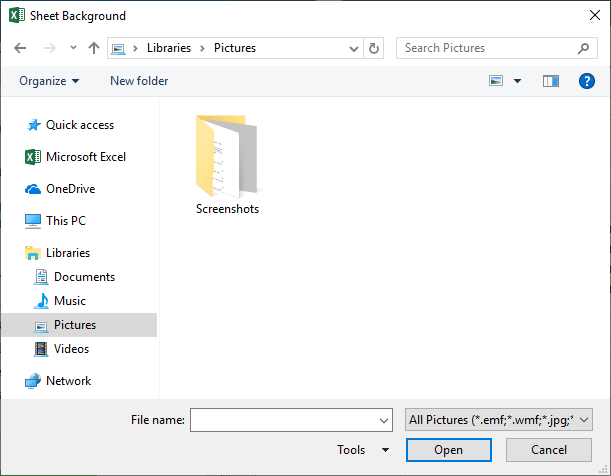Please Note: This article is written for users of the following Microsoft Excel versions: 2007, 2010, 2013, 2016, 2019, 2021, and Excel in Microsoft 365. If you are using an earlier version (Excel 2003 or earlier), this tip may not work for you. For a version of this tip written specifically for earlier versions of Excel, click here: Changing Excel's Background Color.
Written by Allen Wyatt (last updated December 7, 2024)
This tip applies to Excel 2007, 2010, 2013, 2016, 2019, 2021, and Excel in Microsoft 365
The standard background color in Excel is white. You may, at some time, want to change the background color to something else, such as a light grey. Unfortunately, there is no way to change the background color; it is not a configurable option in Excel. There are a few things you can try as workarounds, however.
One approach involves selecting all the cells in the worksheet and applying a fill color to the cells. If you don't want the color to print, then you simply need to select all the cells and remove the fill color. This could be automated by using a macro to do the color removal, printing, and re-application.
There are drawbacks to such an approach, however. First, the colors used to fill the cells could interfere with the successful application of conditional formatting, if the conditional formatting involves the use of fill colors. (Conditional formatting applied to font specifications shouldn't be a problem.) Plus, adding a fill color will obscure the visibility of the grid lines, which makes it a bit more difficult to navigate through your worksheet.
Another option is to create, in your favorite graphics program, a small rectangle that matches the color you want used for your background. Save the small rectangle as a graphics file, using the PNG file format. Then, within Excel, follow these steps:

Figure 1. The Sheet Background dialog box.
The graphic image is placed in the background and repeated over and over again so that it fills the entire background. The benefit to this approach is that it doesn't affect any conditional formatting and the background image won't print.
Speaking of conditional formatting, if you aren't using conditional formatting for any purpose in a worksheet, you could use it to create your background. In a blank area of your workbook, define a cell that contains the value True. Then select your worksheet that you want to have the background color and use a conditional format to define that color. The format can look at the cell you defined, and if it is True, then the color is applied. If the cell is not True, then the color is not applied. This allows you to turn the background color on or off (for printing) by changing the value of a single cell.
You could also define styles for use in your worksheet. Define a style that has the desired background color, and another that does not. You can then apply the colored style when editing and the non-colored style when preparing to print.
ExcelTips is your source for cost-effective Microsoft Excel training. This tip (6121) applies to Microsoft Excel 2007, 2010, 2013, 2016, 2019, 2021, and Excel in Microsoft 365. You can find a version of this tip for the older menu interface of Excel here: Changing Excel's Background Color.

Best-Selling VBA Tutorial for Beginners Take your Excel knowledge to the next level. With a little background in VBA programming, you can go well beyond basic spreadsheets and functions. Use macros to reduce errors, save time, and integrate with other Microsoft applications. Fully updated for the latest version of Office 365. Check out Microsoft 365 Excel VBA Programming For Dummies today!
When getting ready to print your worksheet, you may want to take a moment to check what margins Excel will use on the ...
Discover MoreGot just a small amount of worksheet data to print out? It might look better on the printed page if you center it. Excel ...
Discover MoreHave you ever been using a workbook, only to open it one day and find that Excel has changed the height of your rows or ...
Discover MoreFREE SERVICE: Get tips like this every week in ExcelTips, a free productivity newsletter. Enter your address and click "Subscribe."
There are currently no comments for this tip. (Be the first to leave your comment—just use the simple form above!)
Got a version of Excel that uses the ribbon interface (Excel 2007 or later)? This site is for you! If you use an earlier version of Excel, visit our ExcelTips site focusing on the menu interface.
FREE SERVICE: Get tips like this every week in ExcelTips, a free productivity newsletter. Enter your address and click "Subscribe."
Copyright © 2026 Sharon Parq Associates, Inc.
Comments